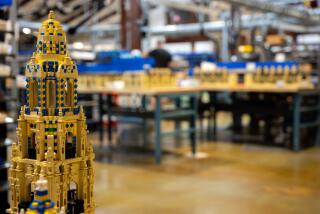Think of the best toy ever
- Share via
IREAD RECENTLY about the new Wii from Nintendo and was reminded of an hour I’d spent in downtown Boston last year, waiting to head back to New York City on the Monday before Christmas.
Wandering through streets transformed since I walked them as a boy in the 1950s, I turned a corner and found myself between Macy’s and Filene’s, on Winter Street. Their storefronts hadn’t changed that much, especially the window displays. Suddenly, I was an 8-year-old back in the days when toys were real.
I was drawn to Macy’s windows, to the automated mannequins, 3 feet tall, arranged in various tableaux, cotton-wool snow everywhere. These tableaux were poignantly corny -- Mom and Dad on the couch by a decorated tree, raising and lowering champagne glasses as their blind heads turned back and forth while, in a spotlight cubby above, the kiddies in their beds were rubbing their eyes with little clay fists, feeling nothing.
But it was the adjacent window that froze me where I stood. It was full of old toys. Not quite antiques, but toys from the 1940s through the 1960s. The little toys were originals. The big ones were represented by miniature models of the originals. There was a sled with slats of white wood set lengthwise along red metal runners attached to a flexible handle bar, allowing for steering -- the Flexible Flyer. I had one exactly like it. All the kids did. There weren’t that many different kinds of things back then.
Ditto the fat-tired Schwinn and the Red Ryder BB gun (“This one’s for you, Little Beaver,” read the display).
I fixated on two little toys in motion: Roy Rogers on a rocking bronco, swinging his lariat on high, and a sea lion with its head thrust up, a beach ball rotating on its nose. Their motions were so tick-tock that they only suggested what they depicted. The difference between the toys and the living beings was underscored by how far the toys fell short of reality, leaving your imagination to make up the difference. Little shells of painted tin, rocking and spinning, on and on, tucked away in a corner of the window. They seemed the embodiment of time.
Reflecting recently on toys the way they were, I saw a way through the controversy over the digital gizmos that dominate the gift lists of our kids today. Parents wonder, even as they buy them: Is this a good thing or a bad thing?
On the level of skills, especially those involving complexity and velocity, immersion in a gadget-laden environment prepares kids for lives that are probably going to get more complicated -- and rushed. And that’s not simply because our kids’ lives will be lived on digital platforms, where technical aptitude is an advantage. It’s also because face-to-face interactions, from the most casual to the most intimate, will also be more complex and pressing.
There are so many more of them than there used to be, for one thing, and so many different contexts within which you have to operate -- and between which you have to glide. The monthly calendar of events and venues for the average family -- school events, meetings at work, children’s extracurricular activities, social obligations -- is so crowded that keeping on track can seem like a full-time job. That’s where that feeling of perpetual “juggling” comes from. That’s why time pressure has become a hot topic in recent years. To be effective in this stuffed environment, you have to be genuinely engaged in each setting, but you also have to be able to disengage and move on as smoothly as your cursor opens the next window.
Just think how little time you have for even your most important relationships, and then think about how undefined, how subject to constant renegotiation they are when you do have time for them. Even if you’ve been more or less happily married for decades, it’s impossible to take it for granted the way our grandparents could.
Virtual toys are preparing kids to manage all this -- especially games like the Sims and SimCity.
On the level of imagination and reflection, however, digital gizmos have disadvantages. If you are deploying toy soldiers around a room to act out a battle you are constantly inventing, you project what’s in your mind onto the world. And your mind has to sustain the result. The complexity of gizmos allow that kind of creativity too, but they -- not your imagination -- do the sustaining.
Think about it this way. If you never read “Pride and Prejudice” but saw the movie first, and then, after seeing the movie, you read the book, there wasn’t much dissonance. Keira Knightly (or Greer Garson, depending on your age) became Elizabeth and Matthew Macfadyen (or Laurence Olivier) became Darcy and, in general, except for some plot changes, you just “saw” the movie in the book. On the other hand, if “Pride and Prejudice” meant something to you as a book, then the movie, no matter how good it was, inevitably clashed with the world you discovered in the book -- not because Jane Austen put it there but because you did. You imagined the whole thing.
Real toys are like books. They beg for imagination.
More to Read
Inside the business of entertainment
The Wide Shot brings you news, analysis and insights on everything from streaming wars to production — and what it all means for the future.
You may occasionally receive promotional content from the Los Angeles Times.










